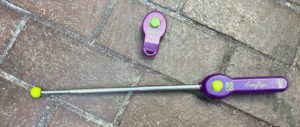Two hours before sunset in Key West, Florida, magicians, jugglers, clowns, musicians, tourists and local residents gather to celebrate the setting sun. One of the more celebrated acts during the daily festival is Dominique Lefort (aka the Cat Man of Key West) and his circus of house cats. During their act, the cats walk on tightropes and jump through hoops of fire.
Cats are known to be independent and untrainable, right? Why would you want to train your cat?
Training your cat = communicating with your cat.
Useful Things You Can Train Your Cat to Do
- Sit on command
- Come when called
- Follow a target
- Take medication
Clicker Training
Clicker Training is a popular method to train horses, dogs, bird, cats and other animals.
Clicker training pairs a clicking sound with a treat or some other thing the cat likes. When the cat hears the click, he knows that a treat or something good is on its way.
If the cat sits when he hears the word “sit” and hears a click as he sits, he will look for his expected reward. If he receives the reward, he will be more likely to “sit” next time upon command.
Clicker Training is based on “POSITIVE REINFORCEMENT”
- POSITIVE – something good (the treat)has been ADDED to sitting on cue
- REINFORCEMENT – Sitting on cue has been ENCOURAGED by offering the treat
Training Your Cat – Reinforcers
Primary

You use the primary reinforcer to encourage the desired behavior. It is something the cat instinctively values – he does not need to learn anything to like food, catnip, or a head rub.
Secondary

Secondary reinforcers cue the cat to look for the primary reinforcer. The clicking sound tells your cat to look for a treat.
The click is a meaningless sound until it is linked with getting a treat. Your cat must learn that “click = treat”.
- Small pieces of food, not enough to fill the cat up.
- Keep the cat’s interest in the reward – have him looking for more. Break cat treats in half for training.
- Catnip: maybe not a good choice. Catnip has more just a simple “yum” message – it can induce a sort of euphoria and delay learning.
- head rubs or play time
Secondary Reinforcers – Why a click?
Repeatable
You could “mark” sitting with a word such as “good kitty” but…it is hard to match your tone of voice and inflection every time. Sharp, staccato sounds get your cat’s attention and do not convey anything other than “yes” or “correct”.
Convenient
You can make a clicking sound with your mouth as well as a “clicker”. If your kitty does not hear well, hand signals could be used, such a holding up your index finger or opening your hand from a fist.
Timing
The click can happen the instant the cat begins to sit. This reinforces the “sit” and not something else the cat may do around the same time. It is awkward trying to use a treat to do this – the click gives you time to get the treat out of your pocket!
CLICK = TREAT
- Get some treats that your cat likes and PUT THEM IN YOUR POCKET (out of sight and smell?)
- Show your cat the clicker and let him smell it
Click and immediately give a treat. Repeat this 4-5 times. - Click first, then treat.
- Train daily if you can, around the same time.
Free Fed?
Pick up food a few hours before training
Special Diet?
Train close to meal times and use his regular food as reinforcers.
Cat Lose Interest?
If your cat looses interest, stop the session and train another time. Aim for a time when he is hungry.
Training your cat gives you an opportunity to communicate with him or her. Cats do best with short, frequent training sessions. Good luck and remember – “the click does the trick”!

